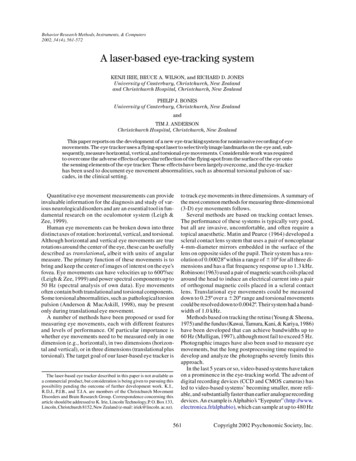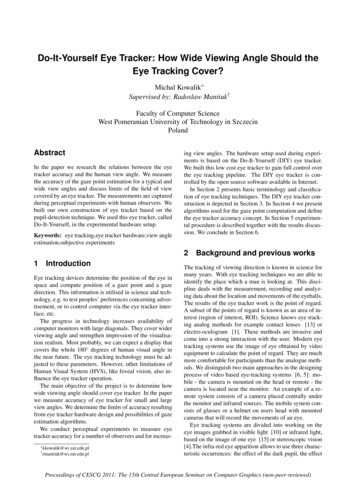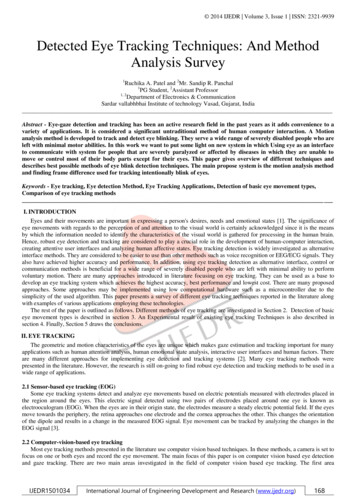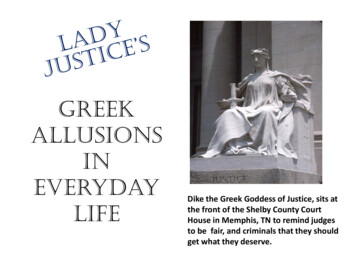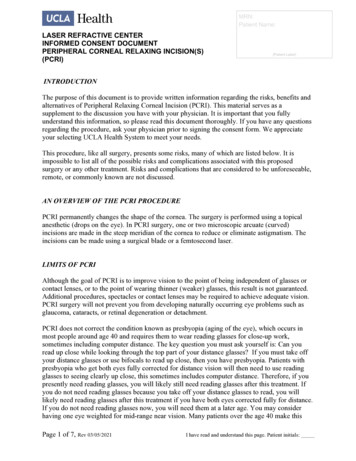
Transcription
WHEN THE EYE REFUSES TO BLIND ITSELF:NABOKOV’S WRITINGS ON LITERATURENataša GovedićIt would seem to us that perhaps itwas really not literature but paintingfor which he was destined fromchildhood Vladimir Nabokov, The GiftAfter all we should keep in mind thatliterature is not a pattern of i d e a s buta pattern of i m a g e s.Vladimir Nabokov, Lectures on Russian LiteratureSight is both image and word;the gaze possible both because of the enunciationsof articulate eyes a n d because the subjectfinds a position to see within the opticsand grammar of language.Peggy Phelan, Unmarked: The Politics of PerformanceIn the narrative realm, the Oedipal myth or the radical negationof the ocular truth demands at least two violent changes of the protagonist’s view: first by self-punishment for the act of incest (madepossible by Oedipus’ inner blindness; regardless of his otherwisehealthy eyes), and then by the “recognition” of a new ethical andpolitical order (made possible by Oedipus’ inner insight; regardlessof his actual loss of sight). In other words, the Theban hero is theking of paradoxical anti-visual violence presented as “necessary”for attaining liberty and knowledge, as well as the king of i n s i g h t “paid for” with v i o l e n c e . Oedipus stands for a cruel(representational) revolution; a change that was communicated byhomicide and suicidal self-mutilation. However, the ethical twist inthe story is connected with the hero’s gain of the ontological “hearing” (comprehension); hearing as final acceptance of himself as theOther. And an absolute other at that – the enemy of the whole community. Through the ear Oedipus also attains feminisation, sincethe ear has been traditionally considered as a substitute for the dis-
236Nataša Govedićplaced female uterus as well as for the “passivity” of mere listening(Phelan 1993: 55). The narrative symmetry therefore follows thepattern: when Oedipus stops being a Penetrating Eye, he becomes aReceptive Ear. Economy of this painful transfer saves his – nowandrogynous – identity. Another important character included inthe Oedipal fiction, wise Tiresias, serves as a model for androgynyequally “paid for” with blindness. As we know from Ovid’s Metamorphoses (book III), Tiresias, who has experienced sexual intercourse with both men and women, lost his sight as a punishmentby Juno for disagreeing with her judgement that men enjoy sexmore than women.Thus it is possible to say that blindness turns Oedipus into Tiresias’ Doppelgänger; into another ambivalent, doublesexed self. Feminist criticism justly had a lot to say about “male gaze” and thehistorical “masculinity” of vision that objectifies women’s body(Mulvey 1975; Lauretis 1984; Irigaray 1985; Williams 1989; Freedman 1991; Kaplan 1996), but the veil of silence still hovers overan unacknowledged semantic capability of patriarchal gaze to turnagainst itself and become self-reflexive and therefore self-critical.And this consciousness of “others” audible within ourselves, andhere I agree with Emmanuel Lévinas (Lévinas 1996), is the utmostethical and the most responsible identity-position. But is it possibleto let the others be visible within ourselves, with equal ethical reflections and consequences?IILet us examine the face behind the masks of this particularanalytical investigation: Nabokov’s literary theory, expressed in hisseminal writings on literature. It has already been sufficiently proven (most recently by Thomas Seifrid, 1996) that Vladimir Nabokov in all his literary works favoured visual over aural: it is his “visual absolutism” that establishes the link between Nabokov andboth the Russian Symbolist movement and the Leo Tolstoy’s “tosee is to be” kind of aesthetic. In Strong Opinions explains his elementary aversion to aural art of music and listening:I have no ear for music, a shortcoming I deplore bitterly. When Iattend a concert – which happens about once in five years – Iendeavour gamely to follow the sequence and relationship of soundsbut cannot keep it up for more than a few minutes. Visual impression,
WHEN THE EYE REFUSES TO BLIND ITSELF 237reflection of hands in lacquered wood, a diligent bad spot over a fiddle, these take over, and soon I am bored beyond measure by the motions of the musicians (Nabokov 1990: 35).Deliberately ambiguous artistic images in the case of Nabokov’swriting style are so much privileged over the discourse and oververbal and philosophical explanations that this craving for the intense pictorial polysemy becomes a literary method:As an artist and scholar I prefer the specific detail to the generalisation, images to ideas, obscure facts to clear symbols, and the discovered wild fruit to the synthetic jam (id., 7).In Nabokov’s story Sounds (Nabokov 1995a [1923]), fictionaldramaturgy includes the hero’s journey from agitated listening ofBach’s music towards peaceful silence. Bach (and all m u s i c) ispresented as beautiful, divine, exciting, but none the less as af a l s e l y u n i f y i n g f o r c e, against which we have the contrast:the image of the tears from the face of the hero’s friend – a v i s u a l O t h e r that breaks the aural harmony of music and selfbeing “one”. Sight is therefore constructed as a principle of metaphysical deferring and differentiation (différance, in Derrida’sglossary). Music is furthermore equated with erotic love and “unityin sound” and “unity in love” are both seen as a threat of total assimilation/identification, from where the hero escapes into the silent, and not very open relationship with his male friend. In thestory Music (Nabokov 1995 [1932]) the concert is only a goldenopportunity for the protagonist Victor to stare at performers andmysterious faces in the audience. The Nabokovian cult of imagesshapes the very specific ontological situation: Oedipal stare intothe taboo of some sort of an Unpenetrable Secret; “silenced” visualscene that finally outroars the concerto itself. This is the author’sfilmic imagination at work – Lolita’s prolonged life on the largescreen supports our thesis sufficiently enough.But Ada (Nabokov 1990c [1969]) is probably the most elaborateNabokov celebration of the visual primacy over the word: “Ad” isthe Russian word for “hell”, while “ardor”, from the the subtitle ofthe novel and from Ada’s nickname, connotes the hero’s passionand sexual ecstasy. It is the chronicle of all the infernal pleasuresat Ardis Hall generated from Van’s visual fascination with Ada’s
238Nataša Govedićchildlike physical beauty and described with the designer’s eye forthe details of her body shape, her ardour, hairstyle, taste and way ofdressing. Just as Lolita was prey to Humbert Humbert’s visualfixation, so Ada is submitted to Van’s constant scopic scanning.Nabokov/lepidopterist is here to observe his favourite “insect”(and his favourite incest) and Nabokov/painter is here to copy hisfavourite model. As if displaying wilfully under the full blow offeminist criticism, or maybe engage personally in the deconstruction of the male gaze, Nabokov provides Ada with a career in thefilm industry: she plays the role of the “dancing girl Dolores” (homage to Lolita’s full name) in the movie called Don Juan’s LastFling. Not only does Van get pleasure from objectifying Ada intomoving pictures, but the whole movie-audience is casted as scopiccollaborator as well. The main part of Van’s intense sexual excitement therefore arises from the fact that Ada is “the most perfect”visual object. She is also a sexy and “forbidden” Jocasta-like variation, only without the incestuous guilt.There is no punishment for Ada’s and Van’s obsessive sensualsymbiosis – the novel ends with the two of them looking at theirown photographs (again, privileged images take over the narration). At that point, Ada is ninety five and Van is ninety sevenyears old. Lifelong “perversion” (or should we conclude that “truelove” always remains somehow unlawful and manneristically insane?) hence becomes panegirically sanctified; Nabokovian Oedipus remains happily blind to the societal order. His vision not onlyescapes the Oedipal matrix of Western literary heritage (by mimesis triumphing over any painful catharsis); it lashes out at Biblicalor the Eden narrative content just as fiercely. Ada brings no punishment, no shame and no eternal Fall. Bodies are happily nakedand the magical garden of childhood imagination is at theirdisposal.Ada also contains many references to the Proustian subject ofthe nature of time, especially in Van’s study called The Texture ofTime. As we know from Speak, Memory (Nabokov 1969) andStrong Opinions (Nabokov 1990 [1973]), Nabokov’s relationshipwith pater tempus focused on the art of memory as the art of visualmemory:
WHEN THE EYE REFUSES TO BLIND ITSELF 239I would say that imagination is a form of memory. Down, Plato,down, good dog. An image depends on the power of association, andassociation is supplied and prompted by memory (id., 78).To remember is the same as to see, to see (in our mind’s eye) isto remember. With so much attention given to the eyes, there is nodoubt that Nabokovian Platonic villains suffer from a listeningdisorder – being enslaved to the visual leaves one almost indifferent to other people’s voices. A paradigmatic example is HumbertHumbert’s “deafness” to Lolita’s cries.But Nabokov is never simply immoral; his iconophilic and educated literary criminals more often than not “lose” or are defeatedon symbolic and ethical grounds. As far as Ada goes, if there is anyhuman or godly disapproval or objection to Van’s and Ada’s incestuous community (maybe even a motion to expel the loversfrom the heavenly site), nobody is there to hear it.In my opinion, Ada is the only Nabokov novel that transcendsthe ethical through the acclamation of aestethical: love and the love of art are presented as fantastically victorious over the plaguesof plain everyday existence and common law. To wit, the theme ofpainful Oedipal combination of exile and blindness does reappearoften in Nabokov’s other Russian and American novels as well.For instance, art gallerist Kretschmar in Camera Obscura (1932)loses his sight in a car accident, and the object of his adulterousgaze, cheap prostitute Magda who dreams of becoming a celebrated movie star, “punishes” the blinded one even further. Still visually obsessive, Kretschmar ends being murdered by Magda.His most significant fault, however, has nothing to do with hissexual persona. In Nabokov’s mind, Kretschmar is guilty of being“competent, but not brilliant” (Nabokov’s Russian version of thenovel quoted according to Medarić 1989: 123). He is condemnedfor being mediocre. As we know from Nabokov writings on Gogol(Nabokov 1961), the frame of mind the writer despised the most isexactly “the average” or “the common” type; just as he consideredposhlost or triviality the greatest possible evil. In other words, Nabokov’s credo might be formulated as follows: daring to shift theinner or social boundary while still communicating with the Otherwithin oneself results in protection of the hero’s sight (case study:hermaphroditic play as part of Ada’s and Van’s metonimical andmetaphorical relationship in Ada); and to fear the consequences of
240Nataša Govedićone’s eccentricity brings the peril of blindness and death (casestudy: Kretschmar in Camera obscura).Just like Ada and Van, each other’s doubles, Kretschmar toohas his own “opposite twin”, Horn. Unlike the mirroringreflections exchanged between the incestuous lovers, Kretschmaris unable to address Horn as his braver, more eccentric and daringside. In Nabokov’s oeuvre there are many novels that narrate thedisability of hero’s eye to blind itself in the sense of becoming Oedipally self-critical or self-reflexive (cathartic). In The Defence, Invitation to a Beheading, Lolita, Bend Sinister, Pnin, Pale Fire,Transparent Things and Look at the Harlequins! visual obsessionscapture or ruin the protagonist because he is trapped in endless,monolithically and monologically obsessive repetition: frameswithin frames of the same visual representations; Referential mania, as Nabokov (Nabokov 1997: 599) names the disease of a character from the story Signs and Symbols. Using different scholarlyterminology, it has been noted that Nabokov as a storyteller, chessplayer or lepidopterist usually works through limitless visual observation and pattern variation (cf. Alter 1970: 45). But the usualway for Nabokov to break the Oedipal pattern of self-denial leadsto the submission of his literary protagonist to self-scrutinisingeven before the outer and/ or inner catastrophe (the plague) has demanded it. Images are not mute, languageless objects: they are subjects that constantly call for translation into the verbal interpretation, being unseparable from the language semiosis (Boehm 1997:67, 74, 76, 77). Nabokov develops the theme of excessive attentiongiven to the translation process called “images to memory” thatsoon becomes another “prison cage” for the hero; a confusing, deceitful game of autistic self-reflections. First Nabokov’s novel,Mashenka, portrays the hero’s fear of direct confrontation with theobject of his obsession: throughout the whole novel Ganin is gathering strength to confront his first love Mashenka (Mary in English translation), but at the very end of the story he neverthelessdecides not to meet her face to face at the railway station. Ganinrefuses to meet the concrete Mashenka because, as Nabokov(1988: 91) says, “he exhausted his memories” and what he was inlove with were only his own lonely visions; not the real girl, Mashenka. Maybe we could conclude that Nabokov’s œuvre beginswith the visually obsessive hero who prefers desire supplements(and infinite prolonging of the desire consumption) over the real/
WHEN THE EYE REFUSES TO BLIND ITSELF 241actual meeting-point with the Other, though, in a much later novel,Ada, similarly visually obsessive protagonist gathers some strengthand faces the fantastic kaleidoscope of his imaginary “otherness”,thereby parting with the emotional and intellectual economy of theisolated self.IIIIn Nabokov’s lectures and/or writings about literature, where“literature” is synonymous with novels of the XIXth and earlyXXth centuries, s i g h t is again and again praised as the most precious means of penetration into the work’s meaning. To see all, tovisualise every detail: that is what Vladimir Nabokov repeatedlydemanded from his students. The method hence resembles “closereading” in a sense that it requires an absolute attention to be paidby the reader to the details of the novel’s setting. Nabokov openshis Lectures on Literature (Nabokov 1980), a book devoted to European literary heritage, with the account of Jane Austen’s Mansfield Park. For the openly chauvinistic Nabokov, Austen’s novel isgiven as “the lowest” point of European literary spectrum. In thefamous Nabokov-Wilson letters (Karlinsy 1978), Nabokov’s entryof 5 May 1950 (reply to Wilson’s suggestion that Austin should beincluded in the soon-to-be-started Nabokov’s Cornell lectures)reads like this:Thanks for the suggestion concerning my fiction course. I dislikeJane, and am prejudiced, in fact, against all women writers. They arein another class.While discussing Nabokov we must never forget the writer’smisogynist stripes, a trade that makes him a far inferior thinker,ethically speaking, to some of his own literary favourites, and bythat I mean authors such as Shakespeare or Pushkin (both of whomare capable of admitting and expressing women’s intellectual power). However, by the May 15th 1950 Nabokov did change hismind slightly about Austin, but only to include Mansfield Park atthe beginning of the course and to describe her to the students withcomments like:Mansfield Park, on the other hand, is the work of a lady and the gameof a child. But from that workbasket comes exquisite needlework art,
242Nataša Govedićand there is a streak of marvellous genius in that child (Nabokov1980: 10).In patriarchal imagination, women are simply not capable ofhaving a grown-up mind. It is kind of entertaining to think of Nabokov’s misogynist philosophy while keeping in our adult mindsthe comment made about another great women-hater, Plato. “Thephilosopher wants to forget – wants to prove – his female origins –illusory” (Diamond 1997: XI). But does he succeed? Well, judgingby the female titles of Nabokov’s novels (Mary, Lolita, Ada) wecan safely say he does not. Now back to lectures.What emerges as impressive from Nabokov’s descriptive pedantry is the fact that the Russian emigrant and Cornell professor isvery careful to treat every novel as an über-historical document; asa “higher truth”; t r u e f i c t i o n. This is his typical formalist approach:The ball at Mansfield Park is held on Thursday the twenty-second ofDecember, and if we look through old calendars, we will see thatonly in 1808 could 22 December fall on Thursday. Fanny Price, theyoung heroine of the novel, will be eighteen by that time. She arrivedat Mansfield Park in 1800 at the age of ten. King George III, a ratherweird figure, was on the throne (Nabokov 1980: 11).In other words, novels are not “social luxury” nor “mere lackingin imagination”; novels are serious matter, where every detail is ofutmost importance. Personally, I also choose to think that the lecturer without the belief in the power of fiction should never take astep toward a university rostrum. The effort Nabokov makes topersuade his students that all great novels are in fact “fairy tales”(cf. id., 2, 10, 125, 133, 270; Nabokov 1981: 103; Nabokov 1983:1) also springs from the trust in transformative emotional power offairy tales world: we are reminded that our chilhood feelings ofdelight about fiction were wise, long-lasting and proper. In Clarissa Pincola Estes’ anthropological study on fairy tales, called Women Who Run With the Wolves (Estes 1997), we find very similarfaith in the healing power of a story framed as a fairy tale, whichparadoxically makes Nabokov even closer to the feminist revaluation of the sensual and corporeal aspects of literature.Besides encouraging his own and his students’ emotional participation in the work of art, Nabokov as a lecturer also liked to play
WHEN THE EYE REFUSES TO BLIND ITSELF 243the part of a Holmes-like expert in “pure and rational logic” of literary analysis. He literally sees himself in a role of a “detective”(“My course, among other things, is a kind of detective investigation of the mystery of literary structures”; Nabokov 1980: 1) andthe Holmesian magnifying glass is meant t o d i s c o v e r the greatest possible number of v i s u a l t r a c e s in the story. A goodnovel is expected to be a rich and minute image-painting. That iswhy Jane Austin is not a teacher’s pet.Her imagery is subdued. Although here and there she paints gracefulword pictures with her delicate brush on a little bit of ivory (as shesaid herself), the imagery in relation to landscapes, gestures, colours,and so on, is very restrained (id., 56).No wonder Virginia Woolf is a non-existent entity for Nabokov:it would probably lead to a complete revision of his chauvinist poetics of vision to admit that a visually hyperevocative writer couldactually appear in the female gender. Dickens, on the other hand,wins Nabokov’s literary contest (id., 63):In our dealings with Jane Austen we had to make a certain effort inorder to join the ladies in the drawing room. In the case of Dickenswe remain at table with our tawny port ( ). If it were possible Iwould like to devote the fifty minutes of every class meeting to mutemeditation, concentration, and admiration of Dickens (id., 64).What stands at the centre of Nabokov’s interest for Dickens are,as we might expect, the older writer’s visual feasts.Weevle complains to Guppy about the atmosphere – mental andphysical – in that room. Mark the candle heavily burning with a greatcabbage head and a long winding sheet. No use reading Dickens ifone cannot visualise that (id., 79).And than the explosion of admiration for Dickens’ descriptivetalent:The first thing that we notice about the style of Dickens is hisintensely sensuous imagery, his art of vivid sensuous evocation (id.,113).
244Nataša GovedićHere we also find Nabokov’s “translational” definitions of v i suality as literariness, and literariness as vis u a l i t y. I apologise to the reader for the considerable length ofthe coming quotation and humbly promise it to be pregnant withsignificance:Literature consists, in fact, not of general ideas but o f p a r t i c u l a r r e v e l a t i o n s, not of a school of thought but of individualsof genius. Literature is not about something: it is the thing itself, thequiddity. Without the masterpiece, literature does not exist. The passage describing the harbor at Dealoccurs at the point when Esther travels to the town in order to see Richard, whose attitude towards life,the strain of freakishness in his otherwise noble nature, the dark density that hangs over him, trouble her and make her want to help him.Over her shoulders Dickens shows us a harbour. There are many vessels there, a multitude of boats that appear with a kind of quiet magicas the fog begins to rise. ( ) Let us pause. C a n w e v i s u a l i s et h a t? Of course we can, and we do so with a greater thrill of recognition because in comparison to the conventional blue sea ofliterary tradition these silvery pools in the dark sea offer somethingthat Dickens noted for the very first time w i t h t h e i n n o c e n ta n d s e n s u o u s e y e of the true artist; saw and immediately putinto words. Or more exactly, without the words there would havebeen no vision; and if one follows the soft, swishing, slightly blurredsound of the sibilants of the description, one will find that t h ei m a g e h a d t o h a v e a v o i c e i n o r d e r t o l i v e (id.,116, e m p h a s i z i n g NG).Other than chauvinistic “theory of the genius” (Romanticismnever entirely left the author of demonic erudite and mastermindHumbert Humbert), what Nabokov offers here theoreticallyamounts to a revelatory connection and e q u a t i o n between tworepresentational media: the image and the word. What connectsthem is the dialogical abundance of meaning; intertextual protestagainst any purism or determinism of representational institutions.As Roland Barthes (1977: 38-39) taught us, “all images are polysemous: they imply, underlying their signifiers, a ‘floating chain’of significants, the reader is able to choose some and ignore theothers.” To translate or transform the image into a text hence always means to “fix” the floating chain; to stop the endless relay ofcoherent semiosis. Furthermore, text is necessary to elucidate images, but text plays a repressive value – text “tames” the images and
WHEN THE EYE REFUSES TO BLIND ITSELF 245invests morality and ideology into their meaning (cf. Barthes,1977: 40). This process Barthes calls “anchorage”. Nabokov’s lectures from the Fifties could not certainly be familiar with any ofthe Barthes’ later theoretical constructs, but Nabokov’s insistenceon the ontology of the image bears close resemblance to the poststructuralist insistence on the permanent ecstasy of finding theplayful, a c t i v e meaning of the text:The poetic or the ecstatic is that in every discourse which can openitself up to the absolute loss of its sense, to the (non-)base of thesacred, of nonmeaning, of un-knowledge or of play, to the swoonfrom which it is reawakened by a throw of a dice (Derrida 1997:261).Nabokov’s interpretative priority is similarly not with thecharacter, nor the structure or the plot; he despises sociological orpsychological analysis of literary work and he avoids adopting anyof the fashionable literary theories o
often in Nabokov's other Russian and American novels as well. For instance, art gallerist Kretschmar in Camera Obscura (1932) loses his sight in a car accident, and the object of his adulterous gaze, cheap prostitute Magda who dreams of becoming a celebra-ted movie star, "punishes" the blinded one even further. Still vi-



